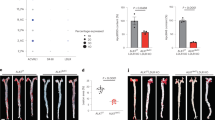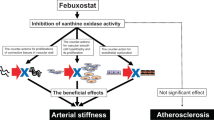Abstract
The possible inhibition of lipid deposition into vascular tissues by a novel angiotensin II type 1 receptor antagonist, olmesartan, was investigated in a primate high-cholesterol model. Twelve monkeys that were fed a high-cholesterol (4% cholesterol and 6% corn oil) diet for 6 months were divided into two groups: one group was given olmesartan medoxomil (10 mg/kg per day), and the other group was given no medication. A further control group of six monkeys was fed a normal diet throughout the study. The level of low-density lipoprotein (LDL) cholesterol was increased by the high-cholesterol diet, whereas that of high-density lipoprotein (HDL) cholesterol was decreased. Olmesartan decreased the areas of lipid deposition on the aortic surface and intimal cross-section area, but not the mean blood pressure and the levels of LDL and HDL cholesterol. The relaxation response of isolated carotid arteries to acetylcholine was suppressed in the high-cholesterol group, but this was improved by olmesartan. Olmesartan inhibited the accumulation of macrophages in the intimal layer. Serum levels of transforming growth factor (TGF)-β1, macrophage colony-stimulating factor (M-CSF) and intracellular adhesion molecule (ICAM)-1 were increased in monkeys fed the high-cholesterol diet, but they were suppressed by olmesartan, although the decrease was not significant. Olmesartan reduced lipid deposition, accompanied by the improvement of vascular functions and the inhibition of macrophage accumulation in the intimal layer and showed a trend towards the suppression of serum TGF-β1, M-CSF and ICAM-1.
This is a preview of subscription content, access via your institution
Access options
Subscribe to this journal
Receive 12 digital issues and online access to articles
$119.00 per year
only $9.92 per issue
Buy this article
- Purchase on Springer Link
- Instant access to full article PDF
Prices may be subject to local taxes which are calculated during checkout




Similar content being viewed by others
References
Dzau VJ . Pathobiology of atherosclerosis and plaque complications Am Heart J 1994 128: 1300–1304
Spence JD, Pesout AB, Melmon KL . Effects of antihypertensive drugs on blood velocity in rhesus monkeys Stroke 1977 8: 589–594
Song K et al. Induction of angiotensin converting enzyme and angiotensin II receptors in the atherosclerotic aorta of high-cholesterol fed Cynomolgus monkeys Atherosclerosis 1998 138: 171–182
Miyazaki M, Takai S . Antiatherosclerotic effect of alacepril, an angiotensin-converting enzyme inhibitor, in monkeys fed a high-cholesterol diet Hypertens Res 1999 22: 49–54
Miyazaki M, Sakonjo H, Takai S . Anti-atherosclerotic effects of an angiotensin converting enzyme inhibitor and an angiotensin II antagonist in Cynomolgus monkeys fed a high-cholesterol diet Br J Pharmacol 1999 128: 523–529
Hernandez-Presa M et al. Angiotensin-converting enzyme inhibition prevents arterial nuclear factor-kappa B activation, monocyte chemoattractant protein-1 expression, and macrophage infiltration in a rabbit model of early accelerated atherosclerosis Circulation 1997 95: 1532–1541
Warnholtz A et al. Increased NADH-oxidase-mediated superoxide production in the early stages of atherosclerosis: evidence for involvement of the renin-angiotensin system Circulation 1999 99: 2027–2033
Kim JA, Berliner JA, Nadler JL . Angiotensin II increases monocyte binding to endothelial cells Biochem Biophys Res Commun 1996 226: 862–868
Nakano N et al. Negative regulation of local hepatocyte growth factor expression by angiotensin II and transforming growth factor-beta in blood vessels: potential role of HGF in cardiovascular disease Hypertension 1998 32: 444–451
Nishimoto M et al. Chymase-dependent angiotensin II formation in the saphenous vein versus the internal thoracic artery J Thorac Cardiovasc Surg 2001 121: 729–734
Sanz M, Ganado P, Ruiz E, Tejerina T . Effect of trandolapril on vascular responsiveness in cholesterol-fed rabbit-isolated arteries Eur J Pharmacol 2000 397: 359–365
Strawn WB et al. Inhibition of early atherogenesis by losartan in monkeys with diet-induced hypercholesterolemia Circulation 2000 101: 1586–1593
Poston RN et al. Expression of intercellular adhesion molecule-1 in atherosclerotic plaques Am J Pathol 1992 140: 665–673
Rajavashisth TB et al. Induction of endothelial cell expression of granulocyte and macrophage colony-stimulating factors by modified low-density lipoproteins Nature 1990 344: 254–257
Ishibashi S et al. Monocyte colony-stimulating factor enhances uptake and degradation of acetylated low density lipoproteins and cholesterol esterification in human monocyte-derived macrophages J Biol Chem 1990 265: 14109–14117
Weir MR, Dzau VJ . The renin-angiotensin-aldosterone system: a specific target for hypertension management Am J Hypertens 1999 12: 205S–213S
Laviades C, Varo N, Diez J . Transforming growth factor beta in hypertensives with cardiorenal damage Hypertension 2000 36: 517–522
Kiarash A et al. Upregulated expression of rat heart intercellular adhesion molecule-1 in angiotensin II- but not phenylephrine-induced hypertension Hypertension 2001 37: 58–65
Okamura A et al. Upregulation of renin-angiotensin system during differentiation of monocytes to macrophages J Hypertens 1999 17: 537–545
Fukuhara M et al. Angiotensin-converting enzyme expression in human carotid artery atherosclerosis Hypertension 2000 35: 353–359
Keidar S . Angiotensin, LDL peroxidation and atherosclerosis Life Sci 1998 63: 1–11
Chen XL et al. Angiotensin II induces monocyte chemoattractant protein-1 gene expression in rat vascular smooth muscle cells Circ Res 1998 83: 952–959
Scheidegger KJ, Butler S, Witztum JL . Angiotensin II increases macrophage-mediated modification of low density lipoprotein via a lipoxygenase-dependent pathway J Biol Chem 1997 272: 21609–21615
Prasad A et al. Acute and chronic angiotensin-1 receptor antagonism reverses endothelial dysfunction in atherosclerosis Circulation 2000 101: 2349–2354
Acknowledgements
This study was supported in part by Grant-in-Aid for Encouragement of Young Scientists 12770048, by Grant-in-Aid for Scientific Research (B) 11470027 from the Ministry of Education, Science, Sports and Culture, Japan.
Author information
Authors and Affiliations
Corresponding author
Rights and permissions
About this article
Cite this article
Miyazaki, M., Takai, S. Anti-atherosclerotic efficacy of olmesartan. J Hum Hypertens 16 (Suppl 2), S7–S12 (2002). https://doi.org/10.1038/sj.jhh.1001393
Published:
Issue Date:
DOI: https://doi.org/10.1038/sj.jhh.1001393
Keywords
This article is cited by
-
Favorable cardiac and aortic remodeling in olmesartan-treated spontaneously hypertensive rats
Heart and Vessels (2009)
-
Treatment of hypertension with olmesartan medoxomil, alone and in combination with a diuretic: an update
Journal of Human Hypertension (2007)



